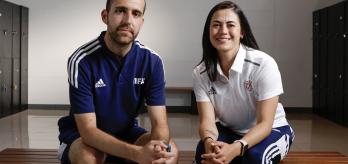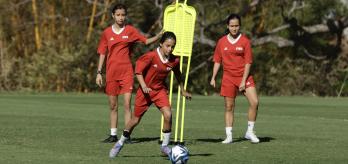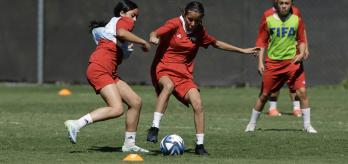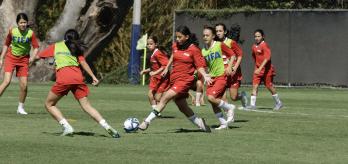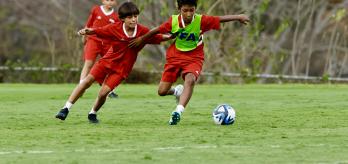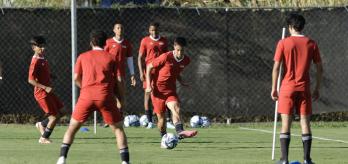In order to break the opposition down and create goalscoring chances, a team need to use a combination of strategies, such as isolating defenders in 1v1 or 2v1 scenarios and threading through-balls in behind the defence. To create goalscoring opportunities, attackers are tasked with playing perfectly weighted passes, while runners must time their runs in behind to perfection.
In this session, FIFA Talent Coach Claudio García and Costa Rican Football Association Talent Coaches Lina Arana and Manfred Schumann deliver a series of passing circuits and final-third exercises to a group of boys. The session gets under way with two passing and finishing activation circuits, followed by a 2v1 final-third sequence in which the attackers are asked to dribble towards defenders and isolate them. The third part of the session involves a 4v4 plus 2 small-sided game in which the attacking team are encouraged to combine with wide neutral players. The session is rounded off with a 11v11 attack v. defence game in which the players are challenged to put all of the principles seen in the previous exercises into practice.
Session overview
Key coaching points
-
Emphasise the importance of combining perfectly weighted passes with
-
well-timed runs in behind when trying to break defensive lines and create goalscoring chances.
-
Players should isolate defenders by dribbling towards them and creating 1v1 scenarios, with out-of-possession team-mates asked to make runs based on the ball carrier’s actions.
-
When involved in combinations, players should play firm passes, adopt an open body shape and offer a number of passing lanes.
-
Ball carriers should be aggressive and positive by playing forwards as much as possible and transitioning quickly.
-
Attacking players should look to stretch defenders by using wide players and breaking into the pockets of space that open up in the defensive lines.
Part 1: Passing and finishing activation circuits
The first part of the session involves two activation exercises that feature three-player passing sequences culminating in a shot on goal. The players are asked to perform short, sharp and incisive actions.
Split the players into 2 groups: one containing 14 players (Circuit A) and the other comprising 8 (Circuit B).
Circuit A
-
Use half of a full-size pitch.
-
Position a full-size goal at the end of the exercise area furthest from the halfway line.
-
Place a goalkeeper in the goal.
-
Use cones to mark out the 2 triangular circuits displayed in the graphic above.
-
Split the players into 2 groups and assign each group to a circuit.
-
Place 3 players at station A and 2 players each at stations B and C.
-
Give each of the players at station A a ball.
Circuit B
-
Use half of a full-size pitch.
-
Position a full-size goal at the end of the exercise area furthest from the halfway line.
-
Place a goalkeeper in the goal.
-
Use cones to mark out the circuit displayed in the graphic above.
-
As indicated in the graphic, place a mannequin a short distance beyond the penalty arc and level with its midpoint.
-
Position 3 players at station A and 2 players each at stations B and C.
-
Place a number of balls at station A.
Circuit A
-
The sequence to be performed in both circuits is the same, with the 2 groups taking it in turns to carry out the exercise.
-
The exercise begins with A in possession.
-
A passes to B.
-
B plays a first-time pass back to A, who makes a short run to meet the return pass.
-
A plays a first-time pass to C before making a run towards goal.
-
C plays a pass into A’s path.
-
A either cuts inside with their first touch before shooting or shoots first-time.
-
Once the sequence is over, players rotate stations in an anticlockwise direction.
Circuit B
-
The exercise starts with A in possession.
-
A passes to B, who makes a short run towards the ball to receive A’s pass.
-
B receives the ball on the half-turn before passing to C and then makes a run towards goal.
-
C plays a return pass either in front of or behind the mannequin into B’s path.
-
B takes a touch to control the ball before shooting on goal.
-
Once the sequence is over, players rotate stations in an anticlockwise direction.
-
After a set period of time, change the set-up so that station A is on the opposite side of the exercise area and switch the positions of stations B and C.
-
Players should play firm and precise passes to the foot of the receiver that helps them to perform their next action.
-
Before receiving the ball, players should open their body and take small steps towards the ball.
-
Passes into the striker must be played into their path to allow them to run onto the ball.
-
If a pass is not firm enough, attackers should meet the ball, cut inside and open their body up to execute a curling shot.
-
Receiving players should advance a few metres from their stations so that they receive the ball on the half-turn.
Part 2: 2v1 final-third moves
The two drills that feature in the second part of the session focus on attacking scenarios, including 2v1s in the final third, with the emphasis on making runs in behind the opposition’s defence. The attackers are tasked with isolating defenders by dribbling towards them, which creates space for team-mates to run into.
Circuit A
-
Use half of a full-size pitch.
-
Position a full-size goal at the end of the exercise area furthest from the halfway line.
-
Place a goalkeeper in the goal.
-
Set up a circuit using cones as shown in the graphic above.
- Place the attacking players (orange) and defenders (blue) as shown in the graphic above.
Circuit B
-
Position a full-size goal at the end of the exercise area furthest from the halfway line.
-
Place a goalkeeper in the goal.
-
Mark out a 20m x 10m defensive zone that runs towards the halfway line from the points where the penalty arc intersects with the penalty area.
-
Place the attacking players (orange) and defenders (blue) as shown in the graphic above
Circuit A
-
The exercise starts with a pass to the first attacking player in the center of the pitch.
-
The player turns and can either pass to a teammate out wide or directly to the furthest attacking player near the penalty box.
-
If the ball is played out wide, the attacking player in possession must find a passing lane to their teammate near the penalty box.
-
The defender attempts to win the ball.
- Variation: A 2v1 is played toward goal, where the attacker in possession decides either to play the ball wide or attack the space inside.
Circuit B
-
The exercise starts with an attacking player dribbling towards the goal.
-
The defender closes them down.
-
An attacker positioned at the attacking station makes a run in behind the defender.
-
The ball carrier can either try to beat the defender in a 1v1 scenario or play an in-behind pass to their team-mate.
-
Once either attacker has progressed beyond the defender with the ball, they must try to score.
-
After a set period of time, change the set-up so that the starting station is on the opposite side of the exercise area.
-
Ball carriers should drive towards the defender and try to unbalance them by using feints and deceptive body movements.
-
When approaching the defender, ball carriers should shift the ball from one foot to the other to enable through-balls to be played with either foot or to open up passing lanes.
-
Players should weigh their passes to enable the recipient to latch onto the ball and shoot without having to break their stride.
-
Attackers looking to latch onto passes played in behind must time their run: if they go too early, they risk being caught offside or allowing the defender to predict the destination of the pass.
-
Attackers should make decoy runs across the back of the defender, allowing the ball carrier to attack the space in behind.
Part 3: 4v4 plus 2 small-sided game
This small-sided game focuses on attackers getting in behind the opposition’s defence and places the emphasis on dribbling, quick combination play with wide players and swift transitions.
-
Position a full-size goal at both ends of the exercise area.
-
Place a goalkeeper in both goals.
-
Narrow the exercise area so that its width matches that of the goal area.
-
Split the group into 2 teams.
-
Set up a 4v4 (plus goalkeepers) scenario inside the exercise area.
-
Position a wide neutral player on the outside of both sides of the exercise area.
-
Place the remaining players beside their respective goals.
-
The exercise starts with one of the goalkeepers in possession.
-
The in-possession team look to progress play and have ten seconds in which to finish on goal.
-
The defending team aim to defend their goal by applying a press.
-
The wide neutral players support the in-possession team.
-
The teams take it in turns to attack.
-
Once each attacking move is over, the 4 players positioned beside the goal enter the exercise area to attack in place of their 4 team-mates.
-
The offside rule applies.
-
If the in-possession team play the ball to a wide neutral player, the wide neutral player on the opposite flank can enter the exercise area and join the attack to create a 6v4 scenario.
-
Attacking players should time their in-behind passes to ensure that runners are able to latch onto them without having to break their stride.
-
Attacking players should use the wide neutral players and constantly make forwards runs to create opportunities for passes to be played in behind the opposition’s defence.
-
Attacking players should dribble aggressively and try to draw in defenders to pull them out of position, enabling the ball to be played in behind them.
-
Players must be conscious of their off-the-ball movement and constantly seek to attack the defensive line.
-
Emphasis should be placed on quick attacking transitions, as this is when the opposition are at their most vulnerable and there is space in behind to attack.
Part 4: : 11v11 game
In the final exercise, the players are asked to put all of the principles worked on in the previous drills into practice in an attack v. defence scenario. Players are encouraged to use combinations, wide play and 1v1 or 2v1 scenarios to create goalscoring chances.
-
Use a full-size pitch.
-
Position a full-size goal at both ends of the pitch.
-
Place a goalkeeper in both goals.
-
Set up a 11v11 scenario.
-
Arrange both teams in a 4-2-3-1 formation.
-
The exercise starts with an attacking-team centre-back in possession on the halfway line.
-
The attacking team aim to progress play and get in behind the defending team, with a view to scoring.
-
The defending team set up in a low block and must stay compact.
-
If the defending team win the ball, they look to quickly break on the counter-attack.
-
Play always restarts with the attacking-team’s centre-back in possession.
-
After a set period of time, swap the teams’ roles so that all players have the opportunity to attack and defend.
-
Well-weighted passes combined with well-timed runs can put attackers in better goalscoring positions.
-
Ball carriers should try to isolate defenders at every opportunity and create 1v1 or 2v1 scenarios.
-
Quick aggressive combinations using angled, forwards passes can help a team to unbalance the opposition’s defence and create goalscoring chances.
-
Attacking players should look to use their wide team-mates as much as possible to stretch the opposition’s defence and enable quick passes to be played in behind.





